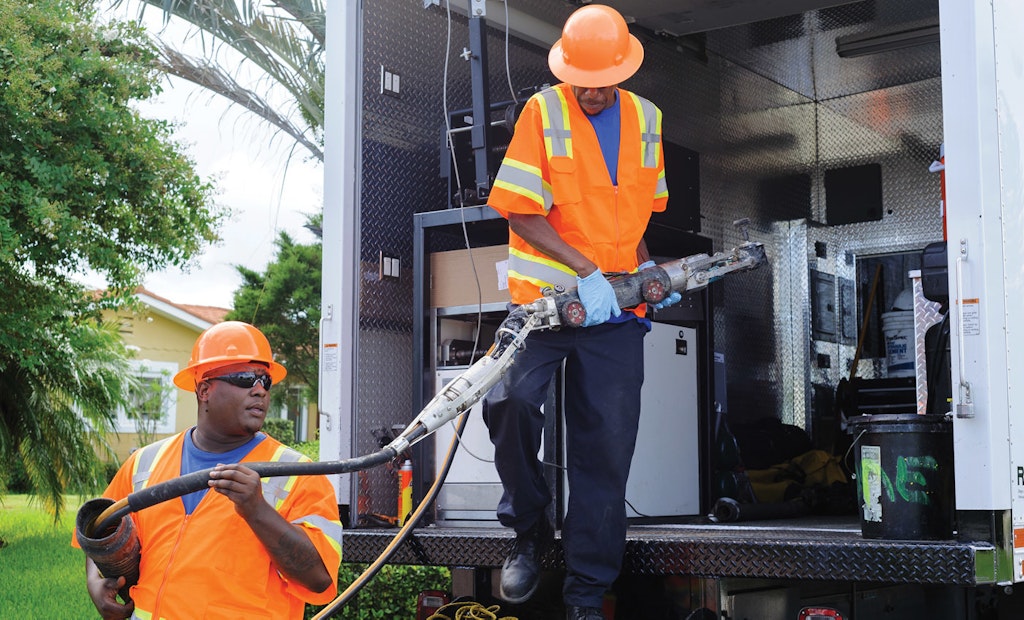
All inspection camera systems are sealed in some way to protect sensitive components from harsh environments. They can be protected from moisture and water through pressurization with an inert gas, or through design standards and are tight enough and strong enough that you don’t need to worry about pressurizing the inside.
Interested in Inspection?
Get Inspection articles, news and videos right in your inbox! Sign up now.
Inspection + Get AlertsInspection equipment is fast becoming a necessity for cleaning operations, and not a cheap necessity either. So when it’s time to invest, contractors need to know that they’re getting the right gear for their operation.
Many factors come into play when purchasing a crawler — among the most important is whether to get a pressurized system. Pressurization provides a small amount of added protection and, most importantly, a warning system for when seals fail.
In the end, it comes down to the specific operation and what works best for each individual crew.
Pressurized systems defined
It’s not as simple as one versus the other: All crawler systems are sealed in some way, shape, or form and exist over a spectrum.
“Any kind of camera that you want to put into a sewer you need to make waterproof,” says William Hunt, regional sales manager for Pearpoint/SPX.
Pressurization itself can add some increased resistance, but the main benefit, regardless of seal quality, is as an early warning system.
“People are wanting more and more bells and whistles in the industry, so the trend is to make things more — have more performance — and so obviously the cost increases, and it’s even more important that we have this early warning system,” says Mark Shires, mechanical design engineer with Aries Industries.
Of course, nothing is simple, and a pressurized system comes with its own challenges: namely, the possibility of moisture introduction via improper repressurization.
Nitrogen is the inert gas of choice for most across the industry, and as long as nitrogen is on hand, the process of bringing a system back up to pressure is simple. It’s when operators find themselves without nitrogen that things become foggy.
Pressurized systems typically go into a low-power, retrieval-only mode when falling below the pressure threshold, making them more or less unusable until brought back to pressure.
Many operators when they are on site and find that their camera is low on pressure, will do whatever they can with what is on hand — which is usually a standard air compressor.
You can repressurize with compressed air, but that introduces moisture, and moisture is the enemy of camera systems like these. In the short term, that moisture will cause problems by fogging the lens, and over time, it will corrode internal parts and circuitry, leading to system failure and subsequent repair.
Aries Industries sells repressurization kits with convenient miniature nitrogen canisters, but the burden is on operators to keep them on hand and to consistently monitor the pressure level of the camera system.
“We see that every now and then in our repair department, where someone’s put air in it,” Shires says. Aries Industries has also begun using a pressurizing port keyed to their nitrogen kits so that it won’t accept a standard air compressor pump.
All about the seal
The alternative to a pressurized system is a simple sealed system. But that doesn’t necessarily equate to an inferior system.
While some sealed cameras are just that, sealed to the bare minimum of watertight, some are designed to withstand far greater stress, such as Pearpoint/SPX’s model, boasting 150 psi pressure resistance.
“That is the base of it right there,” Hunt says. “You have the ability to keep the moisture and the water out by filling it with an inert gas or by designing it tight enough and strong enough that you don’t need to worry about pressurizing the inside.”
Pearpoint/SPX’s system is based off the engineering in its explosion-proof product offerings.
The upside of these systems is less maintenance, and the increased attention to engineering and design provides a high degree of confidence in its seal.
Pressurized systems naturally lose pressure over time and must eventually be repressurized, even if the seals are holding. In part that’s because the injection port itself is an added way for air to escape. The downside of unpressurized systems is that if a seal does fail, you won’t know until it’s too late.
Another aspect to keep in mind when researching systems is that most are compartmentalized, meaning that if a seal does fail, it won’t compromise the entire system.
It’s up to the operators
The question of whether or not to get a pressurized system may lie with operators and their maintenance practices. Does your company have standard preventive maintenance exercises, or is it likely that a particular group of operators might forget to check the pressure before arriving on site without nitrogen canisters?
There are factors that must be determined before even getting into the pressurization debate, such as seal quality.
“We feel like the most important thing obviously is just to make sure the seals are good, reliable seals,” Shires says. “We’ve been working hard the last couple years to improve our seals. … We don’t want customers to have to repressurize frequently.”
Even if you decide the maintenance of a pressurized system isn’t for you, asking about the seals and pressure ratings will ensure that operators don’t end up with an inferior system, which can cost you time and money.





